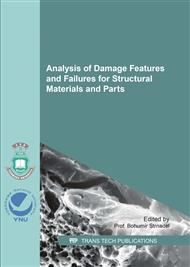p.57
p.63
p.70
p.76
p.82
p.88
p.94
p.99
p.105
Fatigue Crack Growth Simulation Using S-Version FEM: Application to Interacting Subsurface Cracks
Abstract:
In this paper, fatigue crack growth simulation of interacting subsurface cracks using the s-version finite element method (SFEM) is presented. In order to evaluate the accuracy and reliability of the proximity rules published by the ASME, during the fatigue crack growth simulations, the subsurface cracks are approximated to either a single elliptical crack or semi-elliptical surface crack in accordance with the proximity rules. Then, the proximity rules are slightly modified for improving the accuracy and reliability. The results of crack depth evolution calculated by the SFEM with the use of the new proximity rules suggest that the approximation to deep cracks drastically improves the accuracy of the fatigue crack growth evaluation. Thus, the approximation to deep cracks must be a promising approach for having better evaluation of fatigue crack growth of subsurface cracks.
Info:
Periodical:
Pages:
82-87
Citation:
Online since:
June 2017
Authors:
Price:
Сopyright:
© 2017 Trans Tech Publications Ltd. All Rights Reserved
Share:
Citation:


